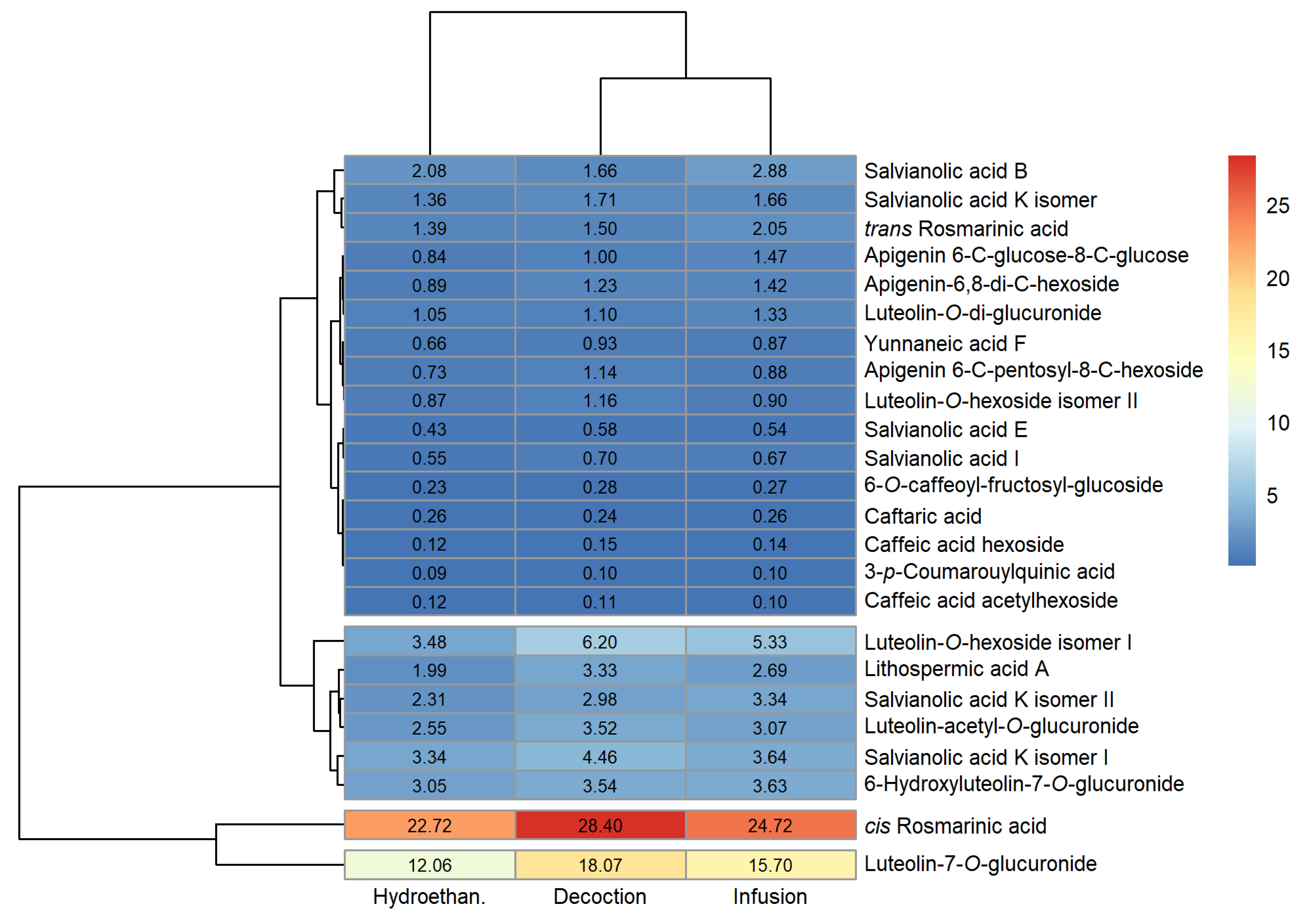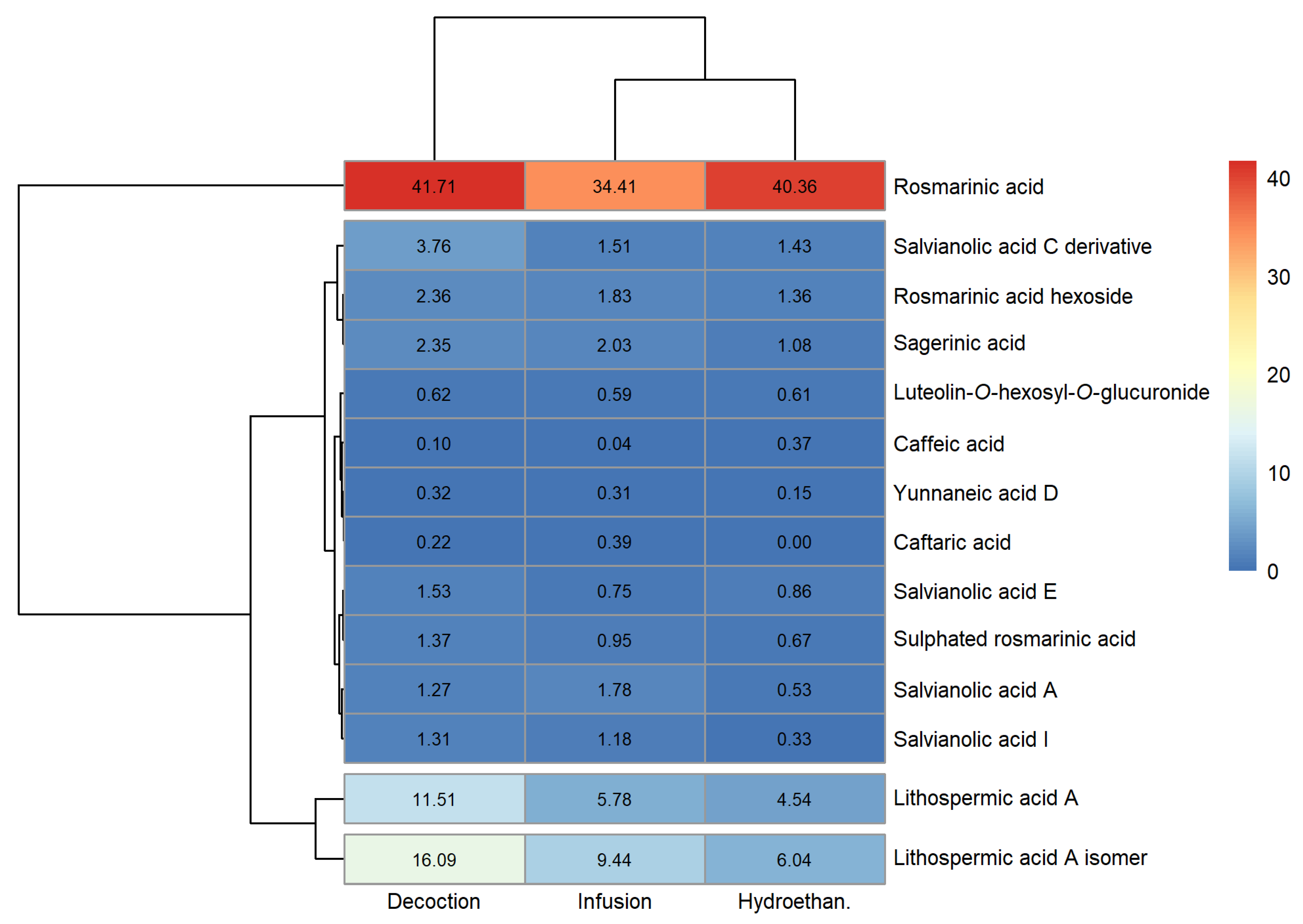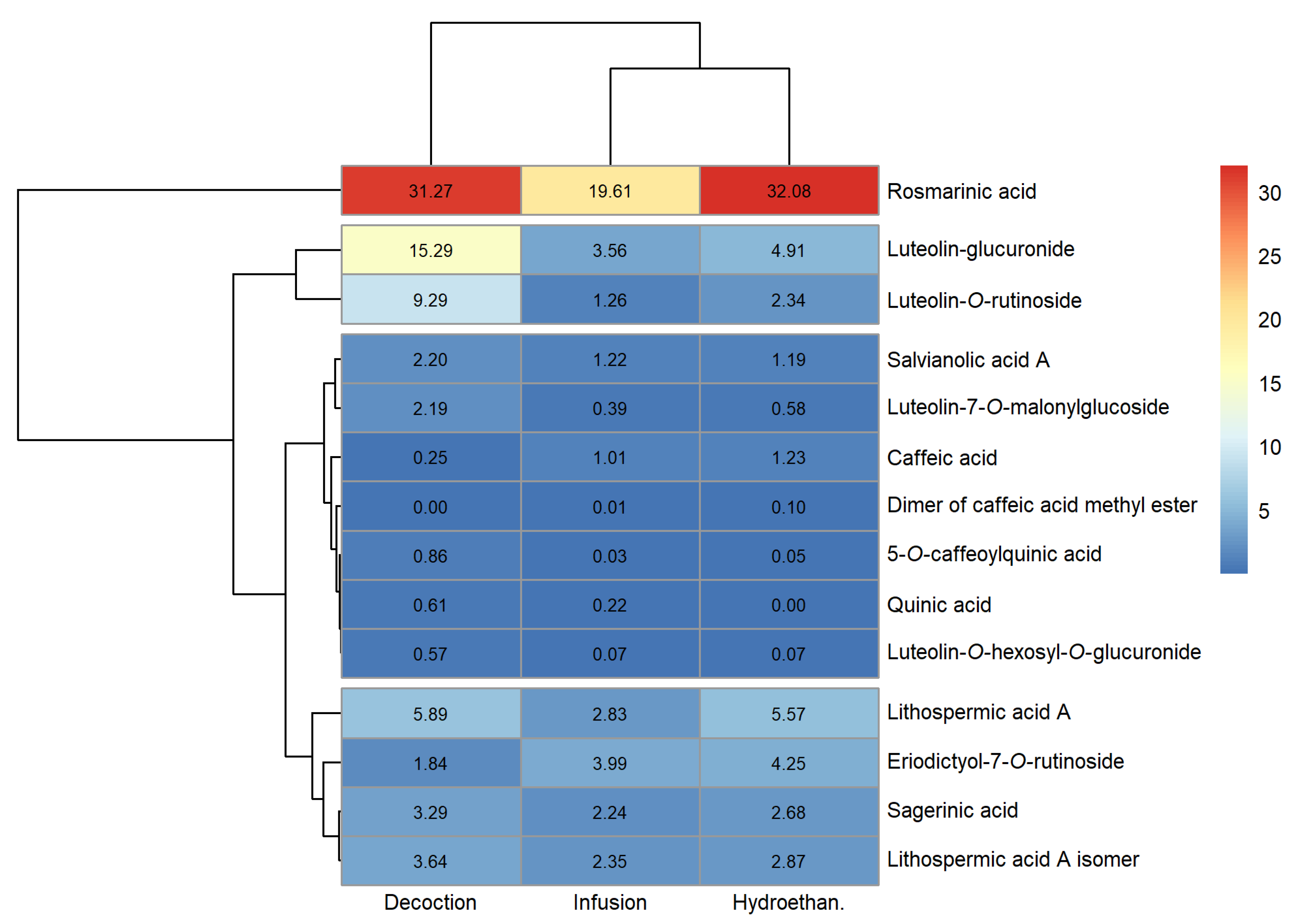Phytochemical Composition and Bioactive Potential of Melissa officinalis L., Salvia officinalis L. and Mentha spicata L. Extracts
Abstract
1. Introduction
2. Materials and Methods
2.1. Plant Material and Extraction Procedures
2.2. Identification and Quantification of Individual Phenolic Compounds
2.3. Biological Evaluation
2.3.1. Antibacterial and Antifungal Activity
2.3.2. Antioxidant Activity
2.3.3. Anti-Inflammatory Activity
2.3.4. Cytotoxic Activity
2.4. Statistical Analysis
3. Results and Discussion
3.1. Phenolic Profile
3.2. Antibacterial and Antifungal Activity
3.3. Antioxidant Activity
3.4. Anti-Inflammatory Activity
3.5. Cytotoxic Activity
4. Conclusions
Supplementary Materials
Author Contributions
Funding
Data Availability Statement
Conflicts of Interest
References
- Mesías, F.J.; Martín, A.; Hernández, A. Consumers’ growing appetite for natural foods: Perceptions towards the use of natural preservatives in fresh fruit. Food Res. Int. 2021, 150, 110749. [Google Scholar] [CrossRef]
- Abiega-Franyutti, P.; Freyre-Fonseca, V. Chronic consumption of food-additives lead to changes via microbiota gut-brain axis. Toxicology 2021, 464, 153001. [Google Scholar] [CrossRef]
- Donato-Capel, L.; Garcia-Rodenas, C.L.; Pouteau, E.; Lehmann, U.; Srichuwong, S.; Erkner, A.; Kolodziejczyk, E.; Hughes, E.; Wooster, T.J.; Sagalowicz, L. Technological Means to Modulate Food Digestion and Physiological Response. In Food Structures, Digestion and Health; Boland, M., Golding, M., Singh, H., Eds.; Academic Press: Cambridge, MA, USA, 2014; pp. 389–422. [Google Scholar] [CrossRef]
- Putnik, P.; Lorenzo, J.M.; Barba, F.J.; Roohinejad, S.; Režek Jambrak, A.; Granato, D.; Montesano, D.; Bursać Kovačević, D. Novel Food Processing and Extraction Technologies of High-Added Value Compounds from Plant Materials. Foods 2018, 7, 106. [Google Scholar] [CrossRef]
- Vinceković, M.; Viskić, M.; Jurić, S.; Giacometti, J.; Kovačević, D.B.; Putnik, P.; Donsì, F.; Barba, F.J.; Jambrak, A.R. Innovative technologies for encapsulation of Mediterranean plants extracts. Trends Food Sci. Technol. 2017, 69, 1–12. [Google Scholar] [CrossRef]
- Spréa, R.M.; Caleja, C.; Pinela, J.; Finimundy, T.C.; Calhelha, R.C.; Kostić, M.; Sokovic, M.; Prieto, M.A.; Pereira, E.; Amaral, J.S.; et al. Comparative study on the phenolic composition and in vitro bioactivity of medicinal and aromatic plants from the Lamiaceae family. Food Res. Int. 2022, 161, 111875. [Google Scholar] [CrossRef]
- Union, Europäische. Directive 2009/32/EC of the European Parliament and of the Council of 23 April 2009 on the approximation of the laws of the Member States on extraction solvents used in the production of foodstuffs and food ingredients. Off. J. Eur. Union L 141 2009, 5, 3–9. [Google Scholar]
- Granato, D.; Santos, J.S.; Salem, R.D.; Mortazavian, A.M.; Rocha, R.S.; Cruz, A.G. Effects of herbal extracts on quality traits of yogurts, cheeses, fermented milks, and ice creams: A technological perspective. Curr. Opin. Food Sci. 2018, 19, 1–7. [Google Scholar] [CrossRef]
- Granato, D.; Nunes, D.S.; Barba, F.J. An integrated strategy between food chemistry, biology, nutrition, pharmacology, and statistics in the development of functional foods: A proposal. Trends Food Sci. Technol. 2017, 62, 13–22. [Google Scholar] [CrossRef]
- Özogul, F.; Tugce Aksun, E.; Öztekin, R.; Lorenzo, J.M. Effect of lavender and lemon balm extracts on fatty acid profile, chemical quality parameters and sensory quality of vacuum packaged anchovy (Engraulis encrasicolus) fillets under refrigerated condition. LWT 2017, 84, 529–535. [Google Scholar] [CrossRef]
- Jakovljević, M.; Jokić, S.; Molnar, M.; Jašić, M.; Babić, J.; Jukić, H.; Banjari, I. Bioactive Profile of Various Salvia officinalis L. Preparations. Plants 2019, 8, 55. [Google Scholar] [CrossRef]
- Cirlini, M.; Mena, P.; Tassotti, M.; Herrlinger, K.A.; Nieman, K.M.; Dall’Asta, C.; Del Rio, D. Phenolic and Volatile Composition of a Dry Spearmint (Mentha spicata L.) Extract. Molecules 2016, 21, 1007. [Google Scholar] [CrossRef]
- Miron, T.L.; Herrero, M.; Ibáñez, E. Enrichment of antioxidant compounds from lemon balm (Melissa officinalis) by pressurized liquid extraction and enzyme-assisted extraction. J. Chromatogr. A 2013, 1288, 1–9. [Google Scholar] [CrossRef]
- Dos Santos-Neto, L.L.; De Vilhena Toledo, M.A.; Medeiros-Souza, P.; De Souza, G.A. The Use of Herbal Medicine in Alzheimer’s Disease—A Systematic Review. Evid.-based Complement. Altern. Med. 2006, 3, 441. [Google Scholar] [CrossRef]
- Garcia, C.S.C.; Menti, C.; Lambert, A.P.F.; Barcellos, T.; Moura, S.; Calloni, C.; Branco, C.S.; Salvador, M.; Roesch-Ely, M.; Henriques, J.A.P. Pharmacological perspectives from Brazilian Salvia officinalis (Lamiaceae): Antioxidant, and antitumor in mammalian cells. An. Acad. Bras. Cienc. 2016, 88, 281–292. [Google Scholar] [CrossRef]
- Adsersen, A.; Gauguin, B.; Gudiksen, L.; Jäger, A.K. Screening of plants used in Danish folk medicine to treat memory dysfunction for acetylcholinesterase inhibitory activity. J. Ethnopharmacol. 2006, 104, 418–422. [Google Scholar] [CrossRef]
- Snoussi, M.; Noumi, E.; Trabelsi, N.; Flamini, G.; Papetti, A.; De Feo, V. Mentha spicata Essential Oil: Chemical Composition, Antioxidant and Antibacterial Activities against Planktonic and Biofilm Cultures of Vibrio spp. Strains. Molecules 2015, 20, 14402–14424. [Google Scholar] [CrossRef]
- Restivo, A.; Degano, I.; Ribechini, E.; Colombini, M.P. Development and Optimisation of an HPLC-DAD-ESI-QToF Method for the Determination of Phenolic Acids and Derivatives. PLoS ONE 2014, 9, e88762. [Google Scholar] [CrossRef]
- Clifford, M.N.; Knight, S.; Kuhnert, N. Discriminating between the Six Isomers of Dicaffeoylquinic Acid by LC-MSn. J. Agric. Food Chem. 2005, 53, 3821–3832. [Google Scholar] [CrossRef]
- Clifford, M.N.; Johnston, K.L.; Knight, S.; Kuhnert, N. Hierarchical scheme for LC-MSn identification of chlorogenic acids. J Agric Food Chem. 2003, 51, 2900–2911. [Google Scholar] [CrossRef]
- Lee, J.S.; Kim, D.H.; Liu, K.H.; Oh, T.K.; Lee, C.H. Identification of flavonoids using liquid chromatography with electrospray ionization and ion trap tandem mass spectrometry with an MS/MS library. Rapid Commun. Mass Spectrom. 2005, 19, 3539–3548. [Google Scholar] [CrossRef]
- Kostić, M.; Smiljković, M.; Petrović, J.; Glamočlija, J.; Barros, L.; Ferreira, I.C.F.R.; Ćirić, A.; Soković, M. Chemical, nutritive composition and a wide range of bioactive properties of honey mushroom Armillaria mellea (Vahl: Fr.) Kummer. Food Funct. 2017, 8, 3239–3249. [Google Scholar] [CrossRef]
- Takebayashi, J.; Chen, J.; Tai, A. A method for evaluation of antioxidant activity based on inhibition of free radical-induced erythrocyte hemolysis. Methods Mol. Biol. 2010, 594, 287–296. [Google Scholar] [CrossRef]
- Silva de Sá, I.; Peron, A.P.; Leimann, F.V.; Bressan, G.N.; Krum, B.N.; Fachinetto, R.; Pinela, J.; Calhelha, R.C.; Barreiro, M.F.; Ferreira, I.C.F.R.; et al. In vitro and in vivo evaluation of enzymatic and antioxidant activity, cytotoxicity and genotoxicity of curcumin-loaded solid dispersions. Food Chem. Toxicol. 2019, 125, 29–37. [Google Scholar] [CrossRef]
- Jabeur, I.; Tobaldini, F.; Martins, N.; Barros, L.; Martins, I.; Calhelha, R.C.; Henriques, M.; Silva, S.; Achour, L.; Santos-Buelga, C.; et al. Bioactive properties and functional constituents of Hypericum androsaemum L.: A focus on the phenolic profile. Food Res. Int. 2016, 89, 422–431. [Google Scholar] [CrossRef]
- Kolde, P. Pheatmap: Pretty Heatmaps. R Package Version 1.0.12. 2018. Available online: https://cran.r-project.org/web/packages/pheatmap/ (accessed on 25 November 2022).
- Nadeem, M.; Imran, M.; Aslam Gondal, T.; Imran, A.; Shahbaz, M.; Muhammad Amir, R.; Wasim Sajid, M.; Batool Qaisrani, T.; Atif, M.; Hussain, G.; et al. Therapeutic Potential of Rosmarinic Acid: A Comprehensive Review. Appl. Sci. 2019, 9, 3139. [Google Scholar] [CrossRef]
- Maliki, I.; Es-safi, I.; El Moussaoui, A.; Mechchate, H.; El Majdoub, Y.O.; Bouymajane, A.; Cacciola, F.; Mondello, L.; Elbadaouia, K. Salvia officinalis and Lippia triphylla: Chemical characterization and evaluation of antidepressant-like activity. J. Pharm. Biomed. Anal. 2021, 203, 114207. [Google Scholar] [CrossRef]
- Silva, B.N.; Cadavez, V.; Ferreira-Santos, P.; Alves, M.J.; Ferreira, I.C.F.R.; Barros, L.; Teixeira, J.A.; Gonzales-Barron, U. Chemical Profile and Bioactivities of Extracts from Edible Plants Readily Available in Portugal. Foods 2021, 10, 673. [Google Scholar] [CrossRef]
- Skendi, A.; Irakli, M.; Chatzopoulou, P. Analysis of phenolic compounds in Greek plants of Lamiaceae family by HPLC. J. Appl. Res. Med. Aromat. Plants 2017, 6, 62–69. [Google Scholar] [CrossRef]
- Oliveira, A.S.; Ribeiro-Santos, R.; Ramos, F.; Castilho, M.C.; Sanches-Silva, A. UHPLC-DAD Multi-Method for Determination of Phenolics in Aromatic Plants. Food Anal. Methods 2018, 11, 440–450. [Google Scholar] [CrossRef]
- Ramasar, R.; Naidoo, Y.; Dewir, Y.H.; El-Banna, A.N. Seasonal Change in Phytochemical Composition and Biological Activities of Carissa macrocarpa (Eckl.) A. DC. Leaf Extract. Horticulturae 2022, 8, 780. [Google Scholar] [CrossRef]
- Guldiken, B.; Ozkan, G.; Catalkaya, G.; Ceylan, F.D.; Yalcinkaya, I.E.; Capanoglu, E. Phytochemicals of herbs and spices: Health versus toxicological effects. Food Chem. Toxicol. 2018, 119, 37–49. [Google Scholar] [CrossRef]
- Panzella, L.; Moccia, F.; Nasti, R.; Marzorati, S.; Verotta, L.; Napolitano, A. Bioactive Phenolic Compounds From Agri-Food Wastes: An Update on Green and Sustainable Extraction Methodologies. Front. Nutr. 2020, 7, 60. [Google Scholar] [CrossRef]
- Abdel-Wahab, M.; El-Sohaimy, S.A.; Ibrahim, H.A.; Abo El-Makarem, H.S. Evaluation the efficacy of clove, sage and kiwifruit peels extracts as natural preservatives for fish fingers. Ann. Agric. Sci. 2020, 65, 98–106. [Google Scholar] [CrossRef]
- Hemeg, H.A.; Moussa, I.M.; Ibrahim, S.; Dawoud, T.M.; Alhaji, J.H.; Mubarak, A.S.; Kabli, S.A.; Alsubki, R.A.; Tawfik, A.M.; Marouf, S.A. Antimicrobial effect of different herbal plant extracts against different microbial population. Saudi J. Biol. Sci. 2020, 27, 3221–3227. [Google Scholar] [CrossRef]
- Ueda, J.M.; Pedrosa, M.C.; Fernandes, F.A.; Rodrigues, P.; Melgar, B.; Dias, M.I.; Pinela, J.; Calhelha, R.C.; Ivanov, M.; Soković, M.; et al. Promising Preserving Agents from Sage and Basil: A Case Study with Yogurts. Foods 2021, 10, 676. [Google Scholar] [CrossRef]
- Caleja, C.; Finimundy, T.; Pereira, C.; Barros, L.; Calhelha, R.C.; Sokovic, M.; Smiljkovic, M.; Carvalho, A.M.; Rosa, E.; Ferreira, I.C.F.R. Challenges of traditional herbal teas: Plant infusions and their mixtures with bioactive properties. Food Funct. 2019, 10, 5939–5951. [Google Scholar] [CrossRef]
- Kolac, U.K.; Ustuner, M.C.; Tekin, N.; Ustuner, D.; Colak, E.; Entok, E. The Anti-Inflammatory and Antioxidant Effects of Salvia officinalis on Lipopolysaccharide-Induced Inflammation in Rats. J. Med. Food 2017, 20, 1193–1200. [Google Scholar] [CrossRef]
- Birdane, Y.O.; Büyükokuroglu, M.E.; Birdane, F.M.; Cemek, M.; Yavuz, H. Anti-inflammatory and antinociceptive effects of Melissa officinalis L. in rodents. Rev. Med. Vet. 2007, 158, 75–81. [Google Scholar]



| Extraction | Plant | SA 1 | BC 2 | LM 3 | EC 4 | ST 5 | EntC 6 |
|---|---|---|---|---|---|---|---|
| Infusion | Lemon balm | 0.5/1 | 1/2 | 0.5/1 | 0.5/1 | 0.5/1 | 1/2 |
| Spearmint | 0.5/1 | 0.5/1 | 0.5/1 | 0.5/1 | 0.5/1 | 1/2 | |
| Sage | 0.25/0.5 | 0.25/0.5 | 1/2 | 1/2 | 0.5/1 | 1/2 | |
| Decoction | Lemon balm | 0.5/1 | 0.5/1 | 2/4 | 1/2 | 0.5/1 | 1/2 |
| Spearmint | 0.5/1 | 0.5/1 | 1/2 | 0.5/1 | 0.5/1 | 1/2 | |
| Sage | 0.5/1 | 0.5/1 | 1/2 | 0.5/1 | 0.5/1 | 1/2 | |
| Hydroethanolic extraction | Lemon balm | 0.5/1 | 0.5/1 | 1/2 | 0.5/1 | 0.5/1 | 0.5/1 |
| Spearmint | 0.5/1 | 1/2 | 0.5/1 | 0.5/1 | 0.5/1 | 0.5/1 | |
| Sage | 0.5/1 | 1/2 | 0.5/1 | 0.5/1 | 0.5/1 | 0.5/1 | |
| E211 7 | 4/4 | 0.5/0.5 | 1/2 | 1/2 | 1/2 | 2/4 | |
| E224 8 | 1/1 | 2/4 | 0.5/1 | 0.5/1 | 1/1 | 0.5/0.5 | |
| Extraction | Plant | AF 1 | AN 2 | AV 3 | PF 4 | PVC 5 | TV 6 |
|---|---|---|---|---|---|---|---|
| Infusion | Lemon balm | 0.125/0.25 | 0.125/0.25 | 0.25/0.5 | 0.5/1 | 0.5/1 | 0.25/0.5 |
| Spearmint | 0.125/0.25 | 0.25/0.5 | 0.25/0.5 | 0.5/1 | 1/2 | 0.25/0.5 | |
| Sage | 0.25/0.5 | 0.25/0.5 | 0.25/0.5 | 0.25/0.5 | 0.25/0.5 | 0.125/0.25 | |
| Decoction | Lemon balm | 0.25/0.5 | >4/>4 | 0.25/0.5 | 0.5/1 | 0.25/0.5 | 0.125/0.25 |
| Spearmint | 0.25/0.5 | >4/>4 | 0.25/0.5 | 0.5/1 | 0.25/0.5 | 0.25/0.5 | |
| Sage | 0.25/0.5 | 0.5/1 | 0.5/1 | 0.5/1 | 0.5/1 | 0.25/0.5 | |
| Hydroethanolic extraction | Lemon balm | 0.5/1 | 0.5/1 | 0.25/0.5 | 0.25/0.5 | 0.25/0.5 | 0.25/0.5 |
| Spearmint | 0.25/0.5 | 0.25/0.5 | 0.25/0.5 | 0.25/0.5 | 0.25/0.5 | 0.125/0.25 | |
| Sage | 0.5/1 | 0.5/1 | 0.25/0.5 | 0.25/0.5 | 0.125/0.25 | 0.125/0.25 | |
| E211 7 | 1/2 | 1/2 | 2/2 | 1/2 | 2/4 | 1/2 | |
| E224 8 | 1/1 | 1/1 | 1/1 | 0.5/0.5 | 1/1 | 0.5/0.5 | |
| Essay | Plant | Infusion | Decoction | Hydroethanolic Extract |
|---|---|---|---|---|
| TBARS 1 | Lemon balm | 125 ± 2.08 a | 204 ± 2.66 b | 206 ± 8.99 b |
| Spearmint | 255 ± 11.0 c | 197 ± 5.68 a | 295 ± 9.77 c | |
| Sage | 235 ± 6.43 b | 196 ± 5.04 a | 132 ± 5.07 a | |
| OxHLIA 2 Δt = 60 min | Lemon balm | 61.4 ± 1.31 b | 27.0 ± 0.43 b | 13.5 ± 0.38 a |
| Spearmint | 83.5 ± 1.84 c | 42.2 ± 0.62 c | 12.5 ± 0.17 a | |
| Sage | 21.9 ± 0.77 a | 8.93 ± 0.44 a | 23.9 ± 0.94 b | |
| OxHLIA 2 Δt = 120 min | Lemon balm | 95.5 ± 2.16 b | 41.6 ± 0.63 b | 27.4 ± 0.85 a |
| Spearmint | 120 ± 1.84 c | 66.8 ± 0.92 c | 27.6 ± 1.28 a | |
| Sage | 38.4 ± 0.89 a | 23.5 ± 0.67 a | 56.4 ± 1.51 b |
| Plant | Infusion | Decoction | Hydroethanolic Extract |
|---|---|---|---|
| Lemon balm | >400 b | >400 b | >400 b |
| Spearmint | 44.4 ± 0.66 a | 43.9 ± 4.26 a | 26.6 ± 1.65 a |
| Sage | >400 b | >400 b | >400 b |
| Extraction | Plant | AGS 1 | CaCo-2 2 | HeLa 3 | MCF-7 4 | NCI-H460 5 | hFOB 6 |
|---|---|---|---|---|---|---|---|
| Infusion | Lemon balm | 215 ± 6.22 a | 290 ± 0.19 b | 249 ± 11.5 a | 239 ± 0.99 b | >400 | >400 |
| Spearmint | 196 ± 7.44 a | 304 ± 0.55 c | 229 ± 21.2 a | 203 ± 1.50 a | >400 | >400 | |
| Sage | 249 ± 8.68 b | 242 ± 0.40 a | 248 ± 25.6 a | 198 ± 0.97 a | >400 | >400 | |
| Decoction | Lemon balm | 255 ± 7.45 b | >400 c | 301 ± 10.9 b | >400 | >400 | >400 |
| Spearmint | 258 ± 5.49 b | 396 ± 0.05 b | 289 ± 1.49 b | >400 | >400 | >400 | |
| Sage | 215 ± 6.25 a | 269 ± 0.31 a | 111 ± 2.14 a | 320 ± 1.05 a | >400 | 350 ± 4.25 a | |
| Hydroethanolic extract | Lemon balm | 231 ± 2.75 b | 351 ± 3.30 c | 266 ± 11.5 b | 180 ± 4.43 a | 369 ± 3.37 a | 271 ± 2.52 a |
| Spearmint | 162 ± 8.05 a | 285 ± 0.43 b | 215 ± 2.21 a | 210 ± 2.20 b | 381 ± 0.63 b | 264 ± 2.29 a | |
| Sage | 361 ± 3.74 c | 272 ± 0.06 a | 257 ± 1.17 b | 206 ± 2.34 b | >400 c | >400 b |
Disclaimer/Publisher’s Note: The statements, opinions and data contained in all publications are solely those of the individual author(s) and contributor(s) and not of MDPI and/or the editor(s). MDPI and/or the editor(s) disclaim responsibility for any injury to people or property resulting from any ideas, methods, instructions or products referred to in the content. |
© 2023 by the authors. Licensee MDPI, Basel, Switzerland. This article is an open access article distributed under the terms and conditions of the Creative Commons Attribution (CC BY) license (https://creativecommons.org/licenses/by/4.0/).
Share and Cite
Silva, B.N.; Cadavez, V.; Caleja, C.; Pereira, E.; Calhelha, R.C.; Añibarro-Ortega, M.; Finimundy, T.; Kostić, M.; Soković, M.; Teixeira, J.A.; et al. Phytochemical Composition and Bioactive Potential of Melissa officinalis L., Salvia officinalis L. and Mentha spicata L. Extracts. Foods 2023, 12, 947. https://doi.org/10.3390/foods12050947
Silva BN, Cadavez V, Caleja C, Pereira E, Calhelha RC, Añibarro-Ortega M, Finimundy T, Kostić M, Soković M, Teixeira JA, et al. Phytochemical Composition and Bioactive Potential of Melissa officinalis L., Salvia officinalis L. and Mentha spicata L. Extracts. Foods. 2023; 12(5):947. https://doi.org/10.3390/foods12050947
Chicago/Turabian StyleSilva, Beatriz Nunes, Vasco Cadavez, Cristina Caleja, Eliana Pereira, Ricardo C. Calhelha, Mikel Añibarro-Ortega, Tiane Finimundy, Marina Kostić, Marina Soković, José António Teixeira, and et al. 2023. "Phytochemical Composition and Bioactive Potential of Melissa officinalis L., Salvia officinalis L. and Mentha spicata L. Extracts" Foods 12, no. 5: 947. https://doi.org/10.3390/foods12050947
APA StyleSilva, B. N., Cadavez, V., Caleja, C., Pereira, E., Calhelha, R. C., Añibarro-Ortega, M., Finimundy, T., Kostić, M., Soković, M., Teixeira, J. A., Barros, L., & Gonzales-Barron, U. (2023). Phytochemical Composition and Bioactive Potential of Melissa officinalis L., Salvia officinalis L. and Mentha spicata L. Extracts. Foods, 12(5), 947. https://doi.org/10.3390/foods12050947














